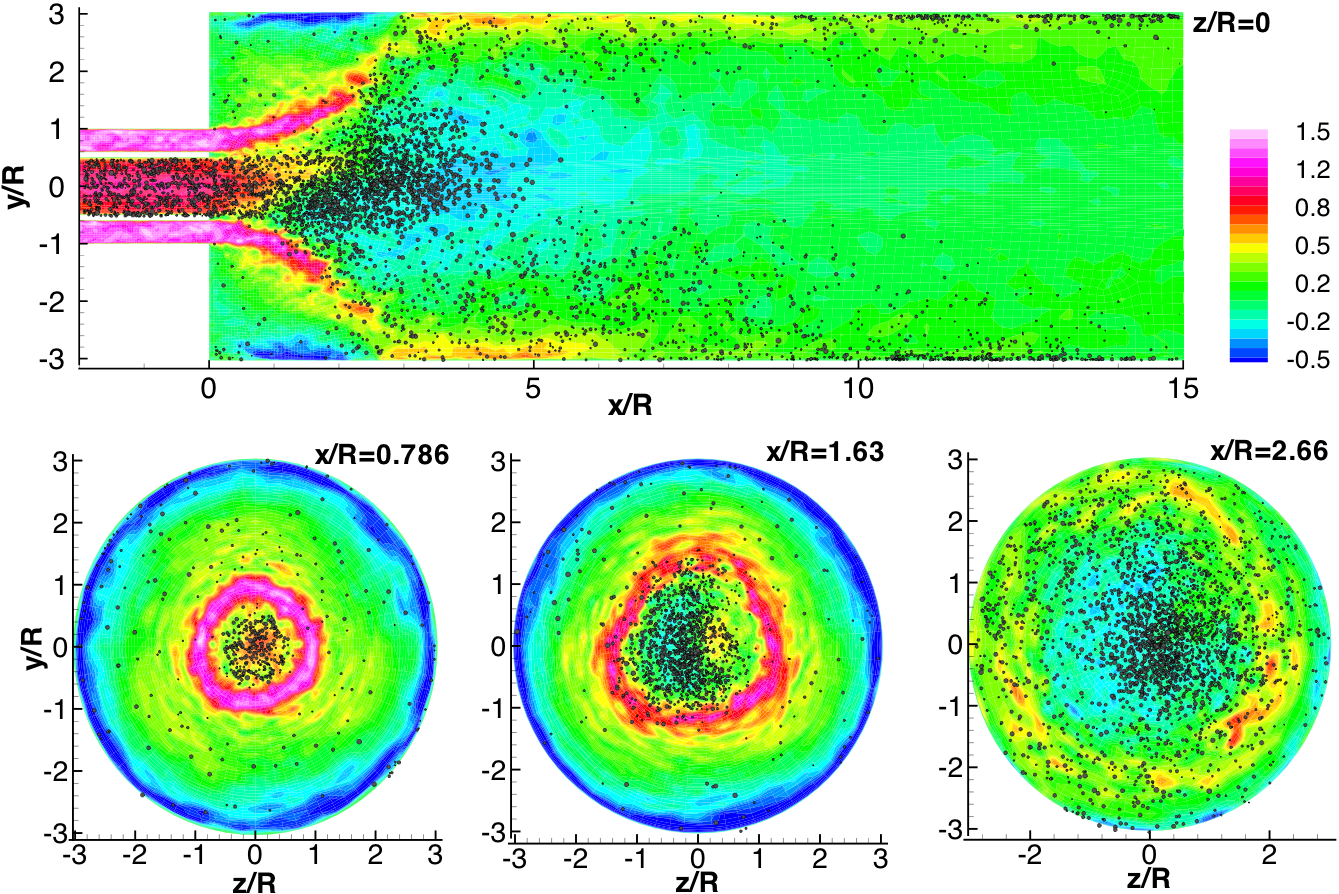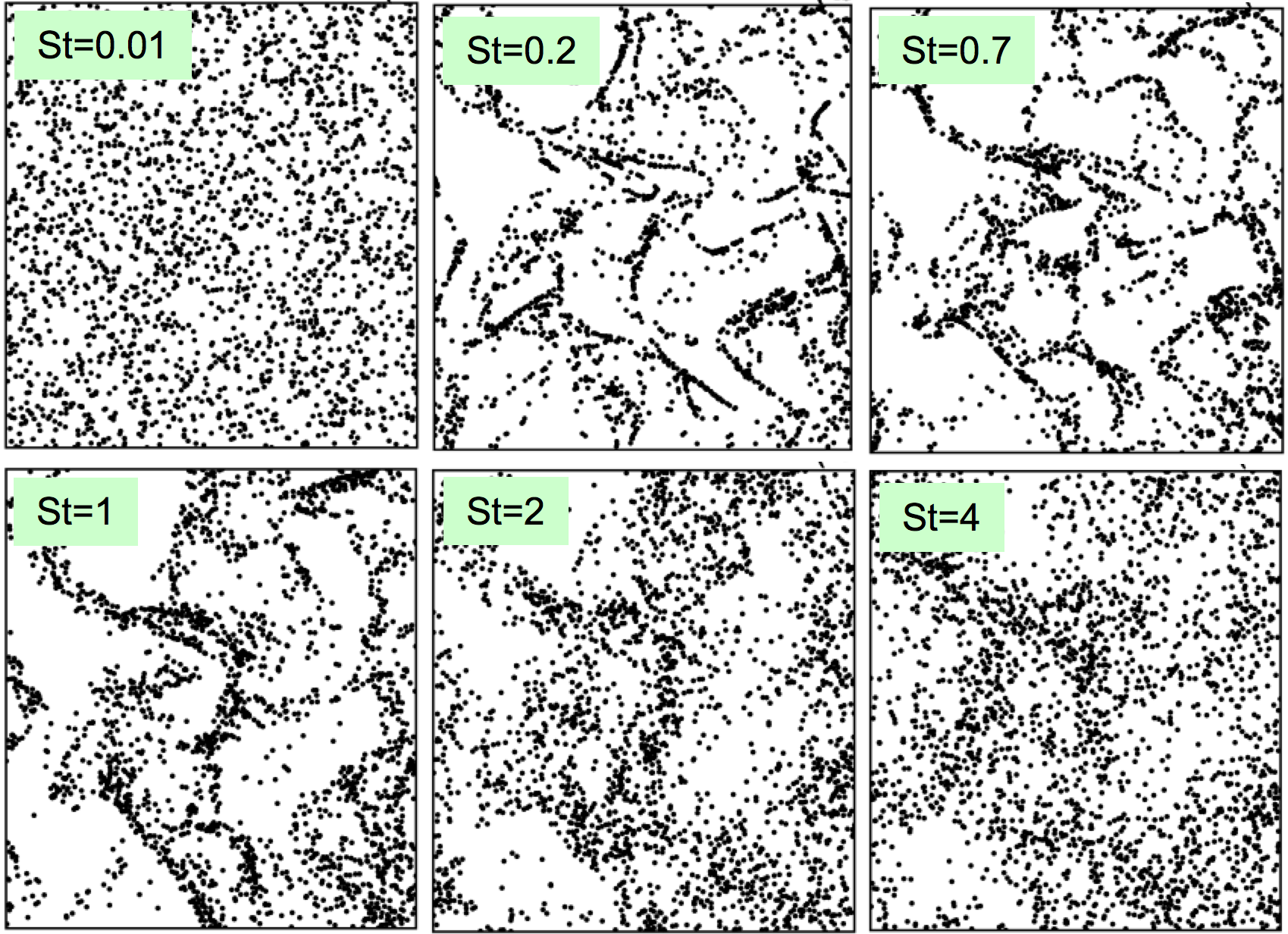|

Large Eddy Simulation of Particle-Laden Turbulent Flows
Many problems in nature and engineering involve multiphase flows where a dispersed phase (solid, liquid, or vapor) exists in the form of a cloud of particles of heterogeneous size in an ambient fluid (gas or liquid) undergoing time dependent and often turbulent motion. Examples include motion and deposition of blood cells in arteries, combustion chambers of propulsion systems, coal gasification and non-conventional biomass-based energy sources, formation and growth of rain-drops, dispersion of hazardous pollutants and atmospheric aerosols, sediment transport, and planets forming nebulae, among others. These apparently diverse applications involving disparate length and time scales involve common physical phenomena of fluid-particle interactions with mass, momentum, and energy transport across the interface between the particles and the surrounding continuum fluid.
 Modeling of particle-laden turbulent flows with low volume loadings typically involves simulations of the carrier fluid using direct numerical simulation (DNS), large-eddy simulation (LES), or Reynolds-Averaged Navier Stokes (RANS) models. The particles are assumed as point sources with size smaller than the Kolmogorov length scale (for DNS) or the grid size (for LES and RANS). The fluid-particle system then is solved using an Eulerian-Lagrangian approach with models for forces acting on the particle. Modeling of particle-laden turbulent flows with low volume loadings typically involves simulations of the carrier fluid using direct numerical simulation (DNS), large-eddy simulation (LES), or Reynolds-Averaged Navier Stokes (RANS) models. The particles are assumed as point sources with size smaller than the Kolmogorov length scale (for DNS) or the grid size (for LES and RANS). The fluid-particle system then is solved using an Eulerian-Lagrangian approach with models for forces acting on the particle.
We have performed large-eddy simulations of swirling, particle-laden flows (see adjacent figure) using an unstructured grid finite volume solver. It was shown that for separated flows such as those occur inside the combustion chambers of gas-turbine engines, a well-resolved LES with conservative numerics can accurately predict the particle dispersion characteristics even with simple subgrid scale models for particle dynamics. For wall-bounded turbulent flows; however, advanced subgrid particle models are necessary and is the focus of our current research in this area. Furthermore, typical point-particle simulations assume spherical size of the particles and neglect angular rotation of particles and their effects on fluid-particle systems. We are working on investigating the effect of particle rotation on the evolution of particle trajectories and fluid flow. Development of new models for torque and particle rotation are necessary.

-
Pozorski, J., and Apte, S. V., 2008, Filtered particle tracking and subgrid-scale dispersion modeling in two-phase turbulent flows, International Journal of Multiphase Flow, accepted for publication. (PDF)
-
Apte S.V., Mahesh, K., and Lundgren, T. 2008, Accounting for finite-size effect in disperse two-phase flow, International Journal of Multiphase Flow, Vol. 34 (4), pp. 260-271. (PDF)
-
Moin, P., and Apte S.V., 2006, Large-eddy simulation of realistic gas turbine combustors, AIAA Journal, Vol. 44(4), pp. 698-708 (Invited Publication in the Special Issue on Combustion Modeling and LES: Development and Validation Needs for Gas Turbine Combustors). (PDF)
-
Apte, S.V., 2004, A multilevel approach for simulating particulate flows, Annual Research Briefs, Center for Turbulence Research, Stanford University and NASA-AMES, pp. 201-208. (PDF)
-
Apte S.V., Mahesh, K., and Lundgren T., 2004, Modeling finite-size effects in LES/DNS of two-phase flows, Fluid Mechanics and Its Applications, Springer Publishing, S. Balachandar and A. Prosperetti (Eds.), Vol. 81(V), pp. 403-412.
-
Apte, S. V., Mahesh, K., Moin, P., and Oefelein, J.C., 2003, Large-eddy simulation of swirling particle-laden flows in a coaxial-jet combustor, International Journal of Multiphase Flow, Vol. 29, pp. 1311-1331. (PDF)
-
Apte S. V., Mahesh, K., and Lundgren, T., 2003, A Eulerian-Lagrangian model to simulate two-phase/particulate flows, Annual Research Briefs, Center for Turbulence Research, Stanford University and NASA-AMES, pp. 161-171. (PDF)
|
|
|
| |
|
©All rights reserved by the Apte Research Group. |

